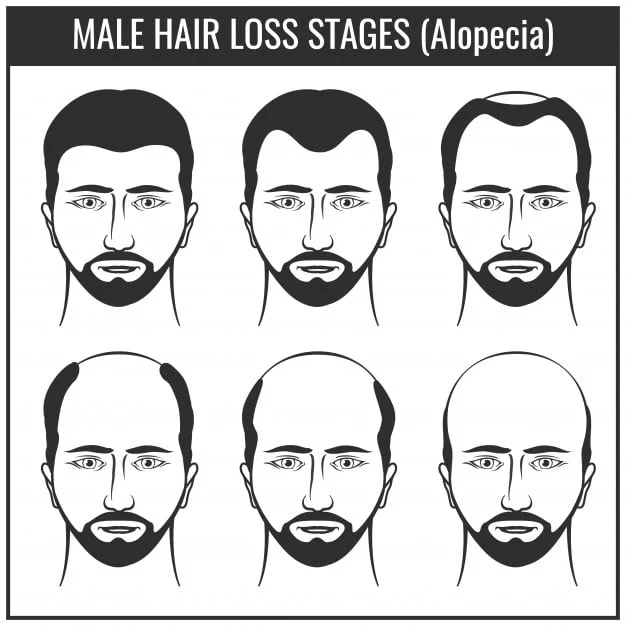

The Norwood scale is used in the clinical evaluation of male pattern hair loss. It has been prepared for the classification of androgenetic alopecia levels in men. It has been an important tool in classifying the stages of hair loss since the day it was prepared. You can learn the stage of your hair loss by examining the Norwood scale table.
The Norwood scale classifies the level of hair loss of someone with androgenetic alopecia. It reveals how the hair will look at what level. People with genetic hair loss can use this scale to examine the level of hair loss and the stages of androgenetic alopecia.
This stage is the first stage of male pattern hair loss. Stage 1 is called minimal or invisible spill. This type of hair loss is generally seen at young ages. At this stage, there is no visible change in the hair. This phase is very difficult to notice. Faint thinning can be noticed by people who pay much attention to the amount of hair strands shed.
There is no treatment that stops genetic hair loss completely. However, hair loss can be significantly slowed down with various drugs and treatment methods in the early period. If your hair is shedding more than normal, we recommend you to see a doctor.
At this stage, regressions begin to be seen in the forehead or the area called the front hairline. Generally, hair loss problem begins to be noticed at this stage. At this stage, the hairline may have regressed about 1 centimeter. The slight setbacks starting from the temples gradually become apparent. The regressions experienced at the junction of the forehead and hair cause the forehead to appear wider.
This stage is the first stage of baldness noticeable from the outside. At this stage, especially the temples were opened. The forehead is 1 – 2 centimeters wide. It is frequently encountered in men in their 30s. In the initial level, a significant change is observed on the forehead. The hill region has not yet begun to open. If the hair loss continues rapidly, the 4th stage is started in a short time.
At this stage, dilutions begin to occur in the vertex area. Support can be obtained from cell regenerative treatments such as PRP treatment to slow down hair loss in spills in the vertex area. Hair transplantation may be required for permanent hair loss.
If you have a 3rd stage vertex shedding, you can contact us to learn your shedding level, analysis of hair structure and type of shedding.
At this stage, the hair is noticeably shed from both the forehead and the crown area. In the light baldness stage, the openings in the vertex area begin to be noticed clearly. At this stage, the front hairline has regressed and the temple areas are opened.
The best treatment for 4th stage hair loss is hair transplantation. Hair follicles can be strengthened with treatment methods such as PRP treatment or hair mesotherapy.
Male pattern hair loss is obvious. At this stage, the openings in the front of the hair and the openings in the crown area begin to merge. It is more common in middle age and beyond. Hair transplantation is the only treatment method for people with baldness at this level. With hair transplantation, the patient can regain his old bushy hair.
This stage refers to the situations where balding is concentrated in the anterior region. In people at this stage, the hair in the nape of the patient is seen as an arc towards the top. There are very few and weak hair follicles in the upper areas. Hair transplantation can be performed if the hair follicles in the donor area are sufficient in people with intense baldness.
At this level, the fronts and top of the hair are completely opened. The person only has hair on the nape of the neck. 2 sessions of hair transplantation are recommended for patients at this level. For people with hair loss Norwood Scale stage 6, an analysis of suitability for hair transplantation operation should be performed.
This stage is the most severe stage of hair loss. At this stage, there is no hair on the top of the head. There is only one strip of hair on the back and sides of the head.
If you are also experiencing permanent hair loss and want to find a solution to this problem as soon as possible, call us.
You can contact us to get information about hair transplantation in our clinic and to learn how you can benefit from this information. By having an initial consultation with Estheticana, you can send photos of the front, top, sides (right-left), and back of your head.
Our patient consultants are here to explain the procedure and prepare a treatment plan for your expectation. Fill out the form and our consultants will contact you shortly.
Scarring may occur in some hair transplantation operations. The…
Hair tansplant specialist is a person who takes the necessary t…
Hair loss or hair thinning is usually caused by hormonal or genetic reasons…
Copyright @ Estheticana.